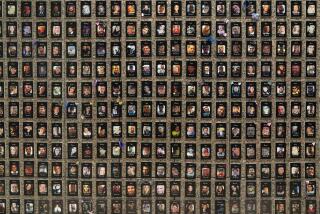End-of-life care, viewed in stark black and white
- Share via
WHEN a visiting nurse suggested that Earleen Jackson consider hospice care, the 68-year-old woman was wary.
“At first I thought they wanted me to come to hospice so I could die here,” said Jackson, who was diagnosed with advanced pancreatic cancer in June. Her son had a similar reaction when she told him about it, the New Haven, Conn., woman recalled.
The Jackson family’s suspicion about hospice and palliative care is not uncommon among African Americans.
When the Rev. Kenric A. Prescott invited members of his largely retired flock to a series of educational sessions on advance planning and hospice care at his Union Baptist Church in Hartford, Conn., only a few showed up. And those who came already had thought extensively about their mortality.
For Prescott, it was a classic case of preaching to the choir.
The apparent resistance of some African Americans to even talk about end-of-life options seems to reflect yet another national chasm between whites and blacks when it comes to access to healthcare.
Recent statistics from the National Home and Hospice Care Survey show that 84% of hospice patients are white, while 8% are African American. Another study suggests that hospice use among African Americans is higher in cities with large minority populations, but blacks still appear to get less end-of-life palliative care than do whites.
“They are suffering as a result of not being able to receive these services,” said Prescott, who is working with VNA Health Care, a large provider of hospice care in the Hartford area, to help African Americans make informed decisions at the end of their lives.
Karen Bullock, a researcher at the University of Connecticut School of Social Work, has been studying end-of-life choices among African Americans since her mother was diagnosed with advanced lung cancer seven years ago.
When her mother decided to discontinue chemotherapy and refused radiation, hospice would have provided a bridge to her death, offering pain relief and emotional and spiritual comfort when a cure was no longer possible. But Bullock didn’t even suggest it.
Hospice offers care for people whose diseases can no longer be cured and who are expected to live for no more than six months. The care is designed to make the dying process as comfortable as possible by providing medical, social and emotional support to the patient and the family. Often the care is carried out at home, although it can also take place in a hospital or nursing home.
But Bullock said her mother would have no part of it. A fiercely independent 67-year-old from North Carolina, she would not hear of having strangers come into her home.
After her mother died, Bullock, who had been studying mental health among the elderly, decided to devote her research to finding out why African Americans seem to be so alienated from the latest, and seemingly most compassionate, approaches to death.
Some of the resistance, Bullock has found, is rooted in mistrust dating from historical atrocities when black Americans were denied decent healthcare or used as laboratory guinea pigs without their knowledge.
Some stems from a deeply spiritual tradition in which God, not a doctor, determines who lives and who dies.
Earleen Jackson, for example, was incensed last June when her doctor told her she had three months to live, saying that only God had the final word. She accepted hospice care after social workers explained that it would give her access to care at all hours and that it would in no way accelerate her death.
But Jessie Spencer, an elder from the Mount Bethel Baptist Church in New Haven, still has her doubts. She recently visited Jackson in the Connecticut Hospice’s large, comfortable hospital.
One hospice’s experience
On any given day, about 15% of patients being cared for by Connecticut Hospice at home or in the hospice’s Branford palliative care hospital are from minority groups. That rate appears to reflect Connecticut’s minority population and is higher than that of many other hospice programs.
Spencer said she worried about the hospice philosophy of discontinuing curative treatment and offering only comfort care once doctors say there is nothing more that can be done.
“I don’t think you should give up. As long as she can take treatment, she can take it,” Spencer said.
As Bullock put it, many blacks “believe in a higher power. They believe in miracles. Many African Americans don’t believe this is the end. They’ll go to church and pray about it, and others will pray for them.”
Often African Americans choose to die in a hospital because they believe that only there will they get all of the treatment medicine has to offer. They are less likely than white patients to sign living wills or do-not-resuscitate orders, sometimes subjecting themselves to desperate and painful measures such as CPR or breathing tubes that may prolong, but not improve, their lives.
“It has resulted in people getting care with no benefit to the patient,” Bullock said.
Like Bullock’s, most of the existing research into racial and ethnic influences on end-of-life decision-making is based on anecdotal information.
The newest study, published this month in the Journal of the American Geriatric Society, used focus groups to look at differences in the way Arabs, Hispanics, blacks and whites approach death.
Author Sonia Duffy, of the Ann Arbor, Mich., Veterans Affairs Hospital, found differences between men and women, as well as among racial and ethnic groups. African American women, for example, said they are comfortable dying in a hospital or nursing home and want everything possible done to maintain life. Black men, on the contrary, do not want heroic measures to keep them alive. The split was similar among Hispanic women and men, with women wanting more extensive intervention than men.
Arabs appear to feel strongly that the family should care for a dying person and do not want heroic measures to maintain life.
Now Bullock is trying to go beyond self-reported opinions and quantify racial gaps in end-of-life care. With a $100,000 grant from the Gerontological Society of America and the John A. Hartford Foundation, she is reviewing the medical charts of 200 African Americans who died at Hartford Hospital and comparing them with a matched group of white patients.
She wants to see how black and white patients compare in signing living wills and do-not-resuscitate orders and whether the groups used the hospital’s palliative care services at different rates.
“We need evidence-based research on which to make recommendations before we can develop strategies for integrating culturally specific components into our care,” Bullock said.
VNA Health Care teamed up with Prescott to offer a series of seven workshops at Union Baptist Church after hospice workers saw that fewer African Americans than they expected sought their services. The Aetna Foundation provided a grant for the program.
Prescott said he wished more people would attend the sessions, which continue monthly through May. But he said he is not surprised by the poor turnout. A few years ago, he offered a lecture series on grief and mourning; very few showed up, even though many church members had recently lost loved ones.
“It’s the fear factor,” he said. “Nobody wants to talk about it.”
‘A fighter to the end’
Paulette Randolph’s husband, Silas Girven, who died in their Hartford apartment last March at age 50, accepted help from VNA Hospice only because he believed it would ease his wife’s burden. “He was Baptist,” Randolph said. “He would tell [the doctor], ‘I’m not going anywhere.’ ”
She said her husband’s doctor suggested hospice care three weeks before he died of cancer. The program supplied a hospital bed and sent nurses, aides and a pastoral counselor to their home. A hospice volunteer stayed with Girven when his wife went to work.
Randolph said her husband told her of his wish to die at home, but never signed a living will or a do-not-resuscitate order. A fighter to the end, he did, however, sign forms giving her power of attorney to make medical decisions for him, Randolph said.
Still, he insisted that he was not dying. And he did not want hospice care.
“He said he wasn’t going to hospice, because hospice was for old people,” recalled Aldine Fray, a VNA nurse who cared for Girven. She spoke about the case with Randolph’s permission. “He said when you go into hospice, you go into a corner and die, and he wasn’t doing that,” Fray said.
A study of patients using a hospice program in Montgomery County, Md., suggests that African Americans may be more receptive to end-of-life care if they have clearer information.
More than 90% of African American caregivers surveyed by researchers in Maryland said hospice met or exceeded their expectations.
The study also suggested that African Americans with higher incomes and more education appeared to be more receptive to end-of-life care than their lower-income peers.
John C. Watson, who retired as chief of code enforcement for the city of Hartford three years ago, called VNA Health Care for hospice services last year after his wife’s breast cancer spread to her brain and could no longer be treated. He said the hospice social worker was especially helpful.
“I’m a talker,” said Watson, 56, who has kidney failure and survives with regular dialysis. “I needed someone to talk to about my feelings.”
Watson said respecting his wife’s wishes to remain at home and undergo no heroic lifesaving measures left him physically and emotionally drained. He said regular visits from the VNA nurses, home health aides and social workers allowed his wife, Veronica, to die at home.
Shortly before she died, Watson rented an SUV and took Veronica for a final visit to Montreal, the couple’s favorite destination, where they had gone 18 or 19 times during their 18-year marriage. Veronica could no longer walk, but the couple drove to their favorite spots and enjoyed a Canadian-style milkshake -- always one of their favorites.
“When we came back, she seemed to have a little sense about her that she had had enough,” Watson recalled. She died peacefully in August 2005, at age 50.
More to Read
Sign up for Essential California
The most important California stories and recommendations in your inbox every morning.
You may occasionally receive promotional content from the Los Angeles Times.













